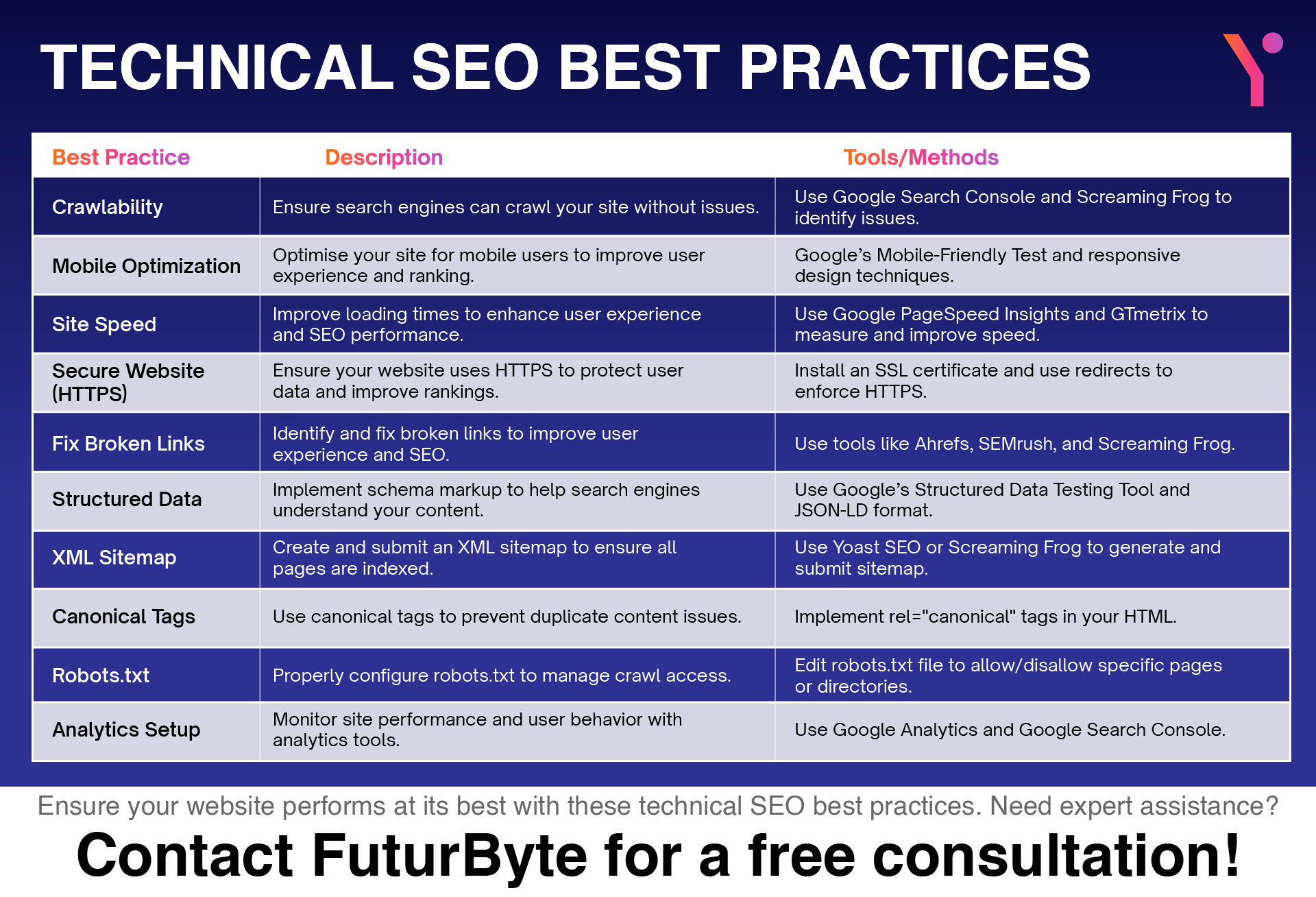Introduction
If you are even remotely confused by SEO, then you need to read this guide. It demystifies technical SEO best practices. You will also get to learn about Google-approved best practices for mobile-friendliness, speed, and more. Skyrocket your website’s search engine ranking today and give a much better user experience via the information presented here.
Search Engine Optimisation (SEO) is considered to be the soul of a website that aims for online visibility. This is why there is so much interest in the right Search Engine Optimisation guide. Within the entire domain of SEO, technical SEO has the potential to lay the foundation for a website’s discoverability.
If you are interested in technical SEO best practices, then this guide is just for you. It will take a deep dive into the best practices that are recommended by Google. By following the practices presented here, you will ensure that you have a technically sound website that can climb high in search engine results pages (SERPs).
If you need any more information regarding technical SEO best practices for beginners or related concepts such as SERPs, then you should contact FuturByte. They are a reputed technical SEO services provider that enjoys a globally situated client base, and they would love to give you free advice on this.
Demystifying Technical SEO
You can think of technical SEO as the immensely powerful invisible force behind your site. You can also take it as a properly organised library that lets librarians (search engines) efficiently search and categorise your books (content). If there is no well-structured library present in the first place, your precious content may stay hidden from possible visitors.
Before getting into technical SEO best practices, note that this is what technical SEO encompass:
Crawlability
This factor ensures that your website’s code and structure let search engine crawlers effortlessly navigate and access your content. This includes the popular Googlebot crawler.
Indexability
This is the optimisation of your website so that it gets included in search engine databases. This will result in your content becoming discoverable across search results.
Website Speed
This refers to optimising website performance for fast-paced loading times. This is generally considered to be an important factor in both search engine ranking and user experience.
Mobile-friendliness
This refers to catering to the mobile-first browsing era by making sure that your site is able to adapt to different devices, such as smartphones and tablets.
Security
This refers to the implementation of security measures such as HTTPS to safeguard user data and increase the trust factor. Of course, this will also benefit SEO.
If you are able to prioritise the stated SEO aspects, you will be able to make a website that is search engine friendly. This will lay the groundwork for better organic traffic and a successful online presence. Want more information regarding HTTPS and how it can benefit you? Contact FuturByte. They are a reputed technical SEO services provider.

Core Web Vitals: Associated with Google’s Seal of Approval
Today, the earning of Google’s seal of approval is considered to be a prominent achievement for any given website that prefers to enjoy a high search engine ranking. Note that this seal is not a literal badge but a shadow of how good your website takes account of Google’s best practices, especially with regard to user experience.
A critical aspect of Google’s approval appears in the shape of Core Web Vitals. If you are unfamiliar with them, then note this: They are a set of metrics that accurately measure a website’s technical performance from a user’s perspective. The emphasis of Core Web Vitals is on the following:
First Contentful Paint (FCP)
The purpose of FCP is to measure the time it takes for the initial content to show on the screen after a user loads a webpage. If there is a fast FCP, this showcases a website that feels both engaging and responsive.
Largest Contentful Paint (LCP)
The purpose of this metric is to emphasise the time that it takes for your webpage’s main content to fully load. This can be an image or the main text. If there is a speedy LCP, then users will not be left waiting for the essential content to appear.
Cumulative Layout Shift (CLS)
This metric measures your website’s visual stability. If there is a low CLS, then this is an indicator that there are elements on your webpage that don’t unexpectedly shift after initial loading, thereby saving users from frustration.
If you are able to properly optimise your website for the Core Web Vitals, you will give a message to Google that your website gives priority to a positive and smooth user experience. This will have a prominent impact on the ranking potential of your website. As a matter of fact, your website will earn Google’s seal of approval in the guise of enhanced search visibility.
Want to know how to easily earn Google’s seal of approval? Call FuturByte. They are a renowned web and application developer that enjoys a globally-situated client base.
Making a Technically Sound Website: Google’s Best Practices
First, let’s focus on crawling and indexability:
Facilitating Search Engines: Crawling and Indexing
You can ensure proper indexing thanks to the Google Search Console. Here, you can submit your sitemap to the Google Search Console. Remember that a rightfully indexed website is an entity that is rather easily discoverable by search engines. This is a highly critical step that will lead towards a site’s search engine visibility.
Mobile-First Indexing: Serving Today’s Users
Google went on to announce mobile-first indexing in 2018. This went on to signify a shift in how today’s leading search engines will prioritise websites. Additionally, it meant that your website’s mobile version would be considered as the primary version utilised for both ranking and indexing. Technical SEO best practices associated with mobile-first indexing take into account the following:
Website Optimisation for Mobile Responsiveness
It is important for your website to seamlessly adapt its functionality and layout to display perfectly on every device, such as smartphones, tablets, and desktops.
If the website is responsive, it will guarantee a satisfactory user experience (UX) on mobile gadgets. This is now considered among highly essential Google ranking factors.
Ensure Seamless Mobile Experience via Mobile-Friendly Testing Tools
Google presents you with free-of-cost mobile-friendly testing tools. These will let you accurately test your mobile’s responsiveness and identify potential areas for improvement. If you are aiming to attain technical SEO success in today’s mobile-first era, you have to utilise Google’s tools and effectively address all the important mobile-friendliness issues.
The Security Factor: Enhancing Trust and Protecting Users
Let’s first focus on the website security element:
Use HTTPS to Secure Your Website
The Hypertext Transfer Protocol Secure (HTTPS) is a secure version of HTTP. Nowadays, it is counted among the important SEO factors. An HTTPS website is capable of encrypting communication between a user’s browser and your website, safeguarding important information and forging user trust. Additionally, search engines prioritise secure websites, which boosts the ranking of HTTPS websites.
Value of a Valid SSL/TLS Certificate
If you want to implement HTTPS, you are required to have a valid SSL/TLS certificate. The certificate will go on to verify your website’s identity, thereby ensuring secure communication. A renowned web hosting provider can help you attain and install a valid SSL/TLS certificate.
Structured Data: The Effective Communication of Your Content
Let’s discuss schema markup first:
Schema Markup: Offering Context to Renowned Search Engines
Here is an informative take on schema markup – this is a type of code that you can include in your site’s HTML. This is done to offer search engines rich data regarding your content. Ultimately, this will aid search engines in their attempts to better understand your content type, the events you host, or the products you sell.
If search engines have a better understanding of your content, they will be able to display your website in much more informative ways across search results. This could possibly lead towards higher click-through rates.
The Gains Associated with Structured Data
Structured data can be utilised to make rich snippets in search results. These can feature information such as author information, event dates, and product ratings. It is because of these rich snippets that you can bring a better visual and informational appeal to your website listings. This can potentially lead to higher click-through rates from users who search for the associated terms.
So far, we have covered some of the fundamental technical SEO best practices that Google has recommended. Here, it is important to state that technical SEO is deemed an ongoing process. This hints at the fact that there are more strategies that you can look into – if you want to optimise your website even more.
Take your Website’s Technical SEO to a Higher Level
Take note of these techniques:
Advanced Technical SEO Techniques
These technical SEO techniques are certainly meant for the advanced users:
Image Optimisation for Fast Loading
True, images have a huge impact on a website’s loading speed. Some of the most renowned technical SEO techniques associated with image optimisation include utilising appropriate image formats such as PNG for graphics and JPEG for photos, compressing image files without compromising on quality, and applying lazy loading to defer non-critical image loading till they are scrolled into view.
Is your website struggling with image optimisation? Call FuturByte. They are a famed progressive website application developer who will offer you sound advice on the matter.
Improved SEO and Navigation via Internal Linking Strategies
Internal linking involves the creation of connections among a host of your website pages. A properly structured internal linking strategy will do more than just enhance your user experience (UX) by letting users easily navigate your website, as it will also distribute link equity across your website. This will possibly shoot up the ranking of vital pages.
Noting the Technical SEO Performance
Let’s discuss Google’s search console first:
Google Search Console: A Door to Beneficial Insights
It has been well-established that the Google Search Console is a free tool that presents you with a great amount of information regarding your website’s technical SEO health. You have the option of using the Google Search Console to monitor indexing status, track Core Web Vitals performance, and identify crawl errors. By addressing those technical SEO issues that have been properly identified in the Search Console, you open the possibility to continuously enhance the search engine visibility of your website.
Website Monitoring Tools
There are a host of website monitoring tools that can prove to be immensely beneficial for tracking technical SEO performance. It is up to these tools to offer alerts for broken links, crawl errors, and website performance issues. When these issues are proactively addressed, you stand a better chance to ensure that you keep your website in a user-friendly and technically sound mode.
Advanced Technical SEO Considerations
So far, we have covered those practices that can create a robust foundation. However, it is important to state here that technical SEO comes as a huge and continuously evolving field. The following are more considerations that can be categorised in the realm of advanced technical SEO:
Technical SEO for Large Websites
Organisations that have huge websites will have a complex structure associated with the sites. Usually, it is in the nature of these structures that demand specialised technical SEO strategies. It could involve the following:
Scalable Sitemap Management
This goes on to ensure that your sitemap crawls and indexes your website’s complete content in an efficient manner.
Log Fine Analysis
This involves the analysis of server logs to identify crawl errors and even user behaviour patterns.
Content Delivery Networks (CDNs)
This involves the distribution of website content throughout servers that are geographically dispersed. This distribution allows faster load times when we cater to a globally spread audience.
Headless Commerce SEO
This is an eCommerce architecture in which the back-end (data and functionality) and front-end (user interface) are decoupled. It offers flexibility, but at the same time, it needs particular technical SEO considerations, such as ensuring proper product data structure and navigation for search engines. Many are of the opinion that headless commerce SEO is an ever-evolving field, which is a debatable point.
International SEO Best Practices
Let’s say that your target audience is situated in more than one country. In this case, it is crucial for you to implement international SEO best practices. This may involve the following:
Hreflang tags
The specification of the target region and language of your site’s content by utilising hreflang tags.
Localised Content
The creation of your website content’s localised versions for different regions and languages.
International Sitemaps
The making of separate sitemaps for every language version of the website.
Take Note of this Important Technical SEO Point
Technical SEO is considered to be an ongoing process. This is why if you keep yourself updated with the newest trends and best practices, then this will allow you to maintain a website that does well in search engine results. In light of this, the following are more helpful points:
Hire a Technical SEO Expert
If your business is targeting advanced SEO strategies or has a complex website, it is best for you to partner with a reputed and experienced technical SEO expert or agency. This is important as their expertise associated with ongoing optimisation, competitor analysis, and technical SEO audits will allow you to boost your website to the top ranks of search engine results.
Need information regarding technical SEO experts? Call FuturByte. They are a globally recognised custom web development service provider.
Seek a WordPress Development Company or a Custom Web Development Service
Perhaps your site needs a prominent degree of structural changes or a full overhaul, and this is in order to optimise for technical SEO best practices. In this case, it would be wise for you to consider collaborating with a WordPress development company (if your site is created on WordPress).
These professionals could make a robust website that is visually appealing. At the same time, the website is technically sound, which will guarantee a reliable foundation for long-term SEO effectiveness.
Going Along with Google Algorithm Updates
One thing is absolutely certain – Google’s search algorithm is evolving on a constant note. On your behalf, it will be best to keep yourself informed regarding the newest updates and amend your technical SEO strategy as required. A piece of good news for you here is that there are various SEO resources and blogs that properly track Google algorithm updates. These sources offer valuable insights on how to adapt your website if you seek continuous success.
Concluding Remarks
No doubt, if you follow the stated technical SEO best practices and keep yourself informed regarding the existing trends, you will be able to make a website that goes extremely well with search engines and is also adored by the users. Additionally, always remember that a technically sound website is directly related to a reliable and resourceful SEO strategy. This will then make way for better user experience, improved organic traffic, and the attainment of your online business goals.
No doubt, this blog has discussed technical SEO best practices in quite detail. If you need further information in this regard, then you should contact FuturByte. They are a well-reputed software solutions provider that enjoys a globally-situated client base, and they would love to assist you with your relative concerns.
Frequently Asked Questions
Generally, these are some of the most vital technical SEO factors for Google:Mobile-friendlinessWebsite speedCrawlability and indexingSecurity with HTTPSCore Web VitalsStructured Data
It is possible that Google goes on to penalise websites that violate its webmaster guidelines. If you seek to avoid this penalty, then this is what you need to do:Emphasise quality contentMaintain a secure websiteDisavow low-quality backlinksRespect robots.txt and user directivesOffer a positive user experience
There are various ways that will allow you to know the overall effectiveness of your technical SEO efforts. These include using the following tools:Website analytics toolsGoogle search consoleRank tracking tools
You can troubleshoot crawl budget issues by doing the following:Identify crawl budget issuesPrioritise high-value contentOptimise website structureSubmit an updated sitemapHere is how you can optimise website architecture:Go with an internal linking strategyImplement breadcrumbsPerform content organisation as per your case
Generally, this question is asked by those who have yet to learn about technical SEO best practices or stay away from the Technical SEO vs on-page SEO debate. Regardless, technical SEO ensures that the site is made for search engines to crawl, index and understand.Additionally, on-page SEO prioritises user experience and content on your website.
The good news for you is that there are various beginner-friendly technical SEO practices for you:Submitting a sitemap to Google Search ConsoleOptimising meta descriptions and title tagsMake sure you have a mobile-friendly websiteStrategically use internal linkingEmphasise on informative, high-quality content
You can use a host of popular technical SEO plugins for WordPress. These include both the free and costly ones. Renowned names here include:Yoast SEORank Math SEORedirectionBefore using a plugin, it will be best for you to do a thorough analysis of your website.
Have questions or feedback?
Get in touch with us and we‘l get back to you and help as soon as we can!




